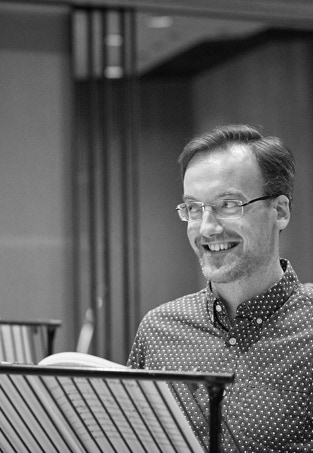St John the Baptist
WITH
Jean-Yves Daniel-Lesur – Le Jardin Clos (1952)
THE IMAGE
Leonardo’s strange image of the smiling Baptist, emerging from a dark substratum of undefined space and pointing upwards to a realm beyond our vision, is unsettling. Conceived towards the end of his career, it reflects his sense of a ‘double truth’, one of which is our rational understanding of the natural laws that govern God’s creation, while the other is the truth of revelation that lies beyond our finite understanding. He deliberately left ‘the definition of the soul. . . to the minds of friars, fathers of the people, who by inspiration possess the secrets. I let be the sacred writings, for they are the supreme truth’. His understanding of the play of light and shade upon form, and his sense of the un-emphatic anatomy of a young person draws upon his empirical researches. Yet the light is as much metaphysical as naturalistic, speaking of spiritual illumination in a dark void. The much-discussed androgyny of the figure transports it from a clearly defined realm of masculine or feminine appeal and into an elusive realm of universal sensuality. Leonardo’s saint exudes erotic spirituality.
The surging curls of the saint’s hair typically speak of the physical parallel Leonardo drew between the curling of hair and the turbulence of water in rapid motion. But here it has a superabundance - like the light reflecting off a ‘flock of goats, shimmering on the slopes of Mount Gilead’, in Daniel-Lesur’s setting - which manifests the saint’s exceptional nature. Above all his inescapable directness draws us to his insistent message about the love to be accorded to the one who comes after him.
MARTIN KEMP
———————————————————————————————————————
THE MUSIC
As a relative Leonardo ingenu, on first view I found this image confusing in its expressive directness. Yet a blurring of expressive lines between sacred and secular is an increasing feature of music from the 16th century and later, notably in the sensual way that composers responded to texts from the Old Testament book of the Song of Songs. It misses the point to read composer responses to this text as erotic or not: it’s more that similar intensity of emotion, whether sacred and secular, can be expressed within the same style. So rather than go to a motet for St John to match this image, we moved laterally to Daniel-Lesur’s 1952 setting of Song of Songs words (the whole set recorded on Amuse-Bouche 00028947893943). ‘Que tu es belle’ was intended not in its literal erotic reading but as the Orthodox Catholic simile for Christ’s love for his church. So why does it do ‘that thing’ to the listener?
ROBERT HOLLINGWORTH

TEXT / TRANSLATION
Que tu es belle ma bien-aimée.
Tes yeux sont des colombes;
tes cheveux comme un troupeau de chèvres
ondulant sur les pentes du Galaad;
tes dents comme un troupeau de brebis tondues
qui remontent du bain;
chacune a sa jumelle.
Tes joues sont comme deux moitiés de grenades
à travers ton voile.
Tes deux seins sont comme deux bichelots
gémaux de la biche qui paissent parmi les lis.
Tu me fais perdre le sens, ma soeur,
ma fiancée, par un seul de tes regards.
Viens du Liban et tu seras couronée
du chef d’Amana!
Elle est un jardin bien clos, ma soeur, ma fiancée,
une source scellée.
Que mon Bien-aimé entre dans son jardin
et qu’il en goûte les fruits délicieux.
How thou art fair, my beloved;
your eyes are like doves;
your hair is like a flock of goats,
shimmering on the slopes of Mount Gilead.
Your teeth are like a flock of sheep that are even-shorn,
after being washed;
each has its twin.
Your cheeks are like two halves of pomegranates
behind your veil.
Your two breasts are like two young roes
that are twins and feed among the lilies.
You have ravished my heart, my sister,
my spouse, with a single glance.
Come from Lebanon, and you will be crowned
on the top of Mount Amana!
A garden enclosed is my sister, my spouse;
a sealed fountain.
May my Beloved go into his garden
and taste its sweet fruits.
Song of Songs, Old Testament
I FAGIOLINI
Solos:
Helen Neeves - soprano
Rebecca Lea - soprano
Ana Beard-Fernandez - soprano
Clare Wilkinson - mezzo-soprano
Peter Gritton - counter-tenor
Eleanor Minney - mezzo-soprano
Nicholas Mulroy - tenor
Nicholas Hurndall Smith - tenor
Matthew Long - tenor
Greg Skidmore - bass
Charles Gibbs - bass
Ben Rowarth - bass

Greg Skidmore
Baritone
Credit Matthew Brodie